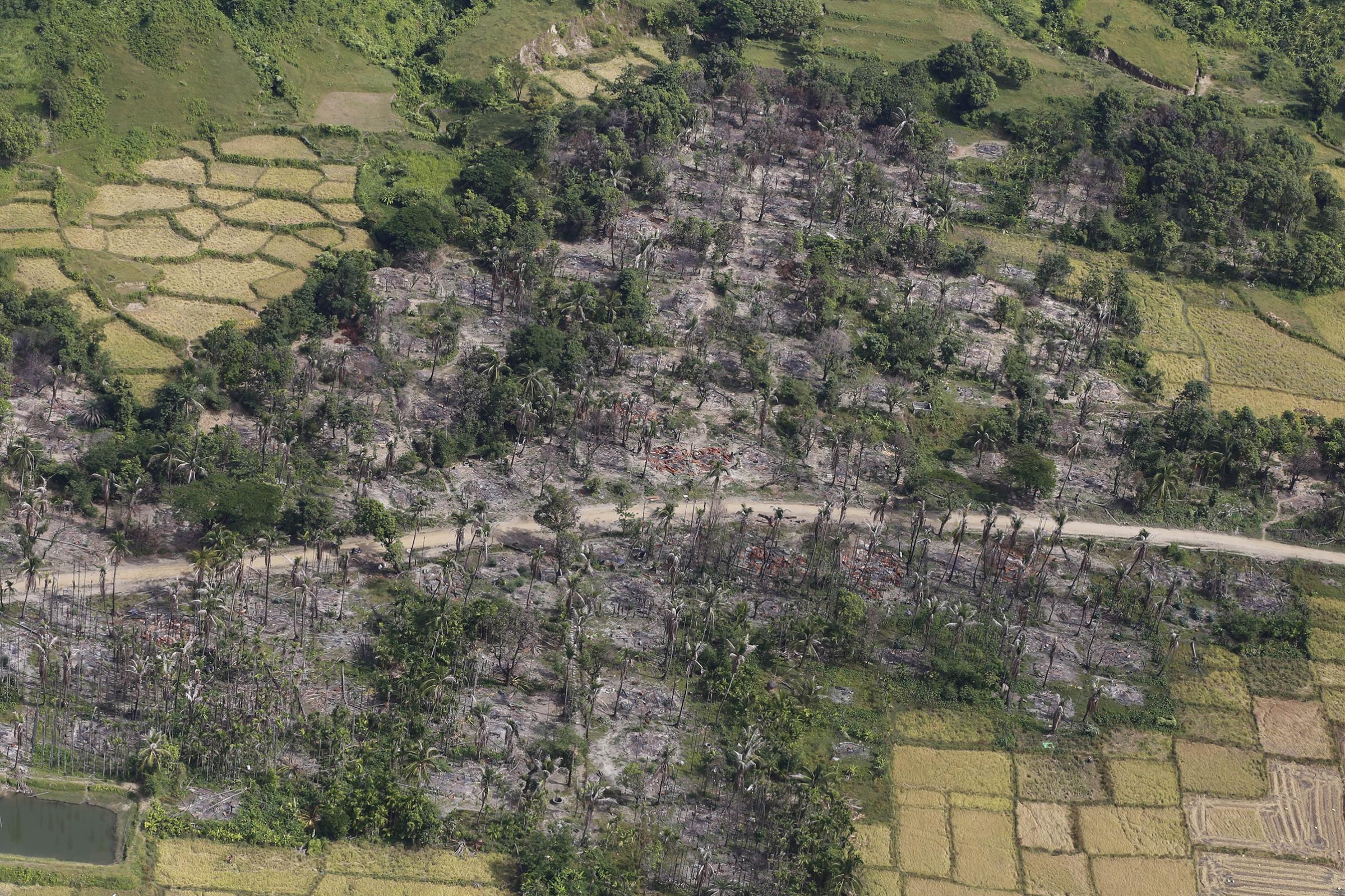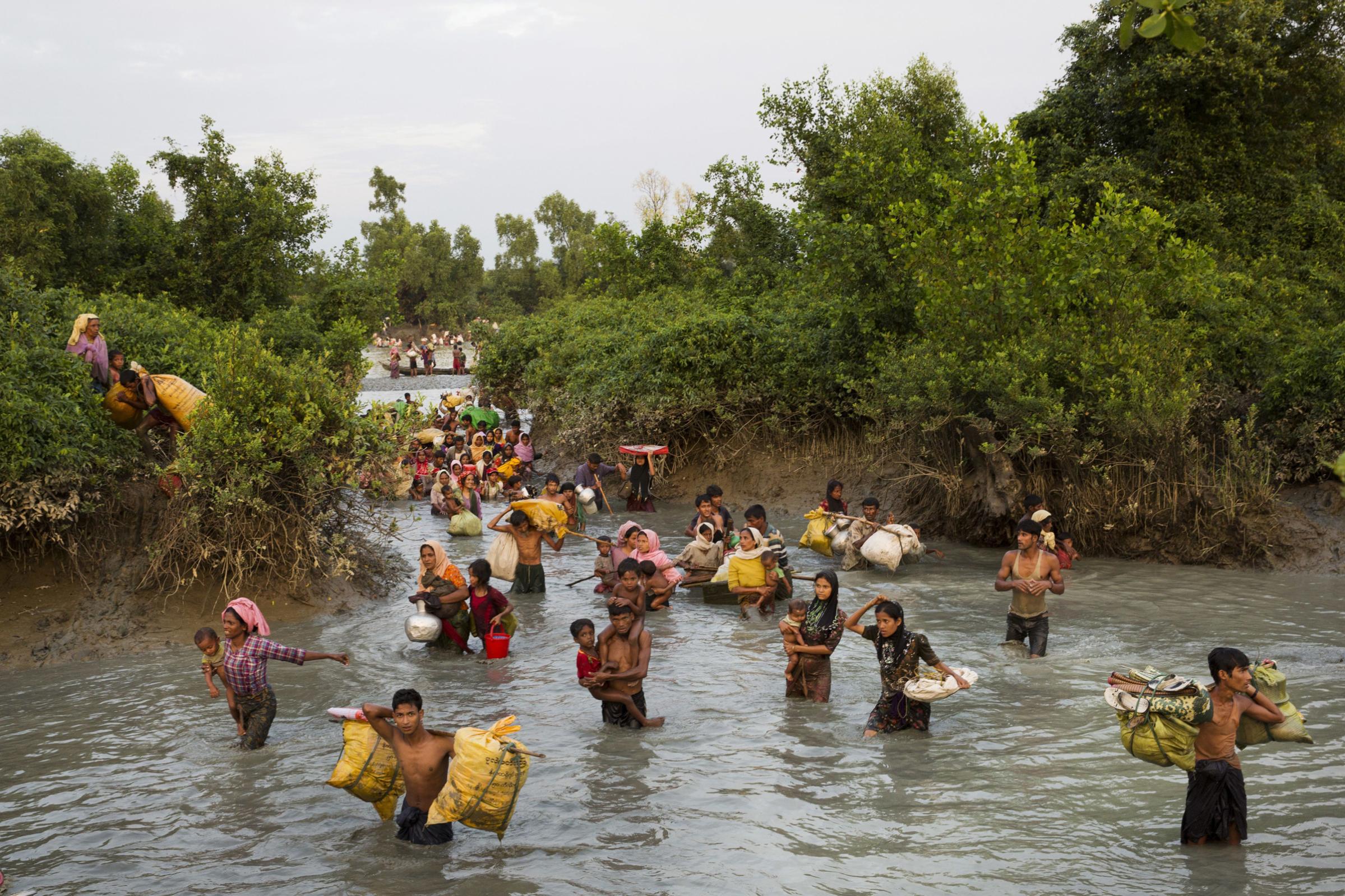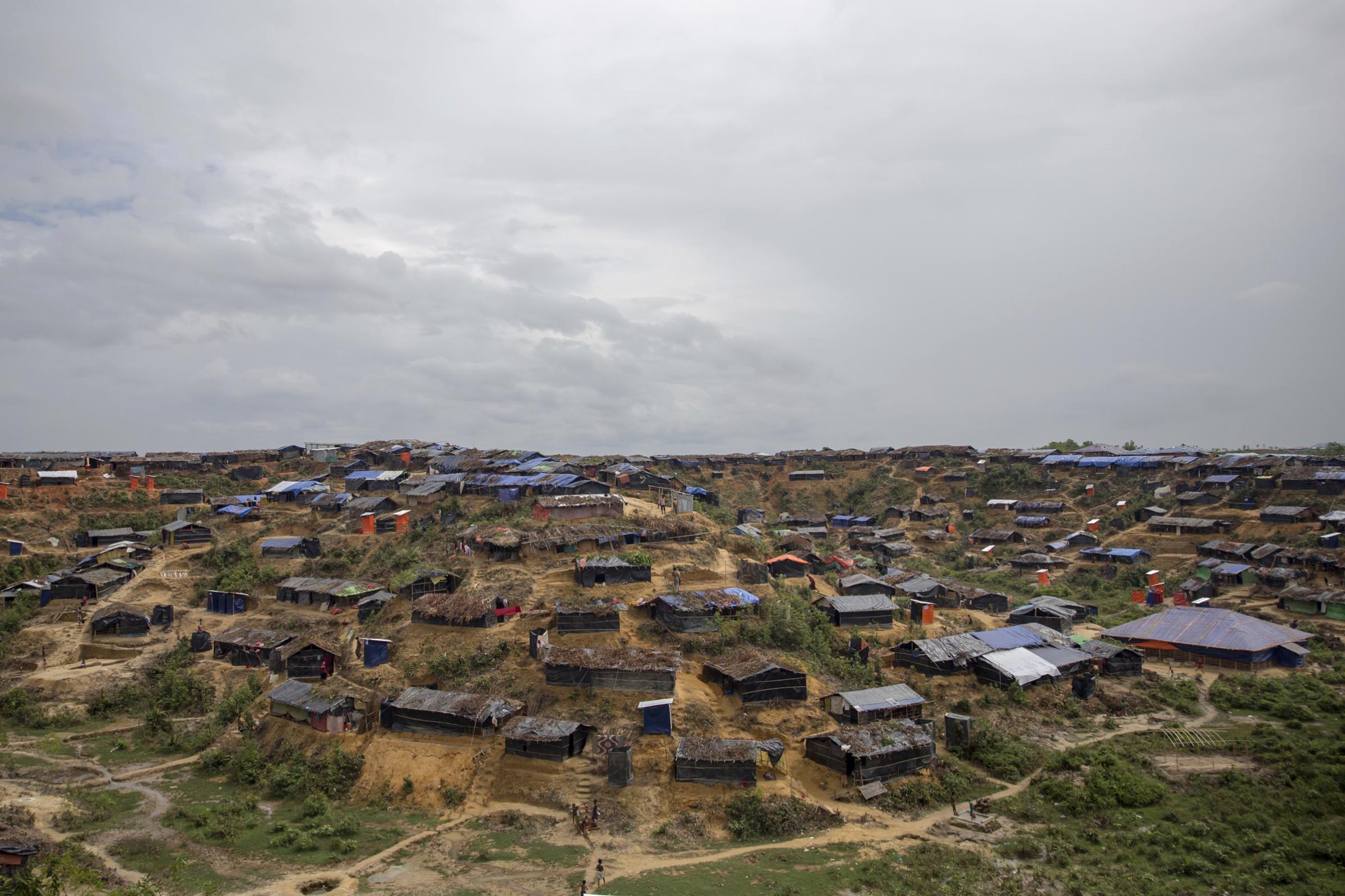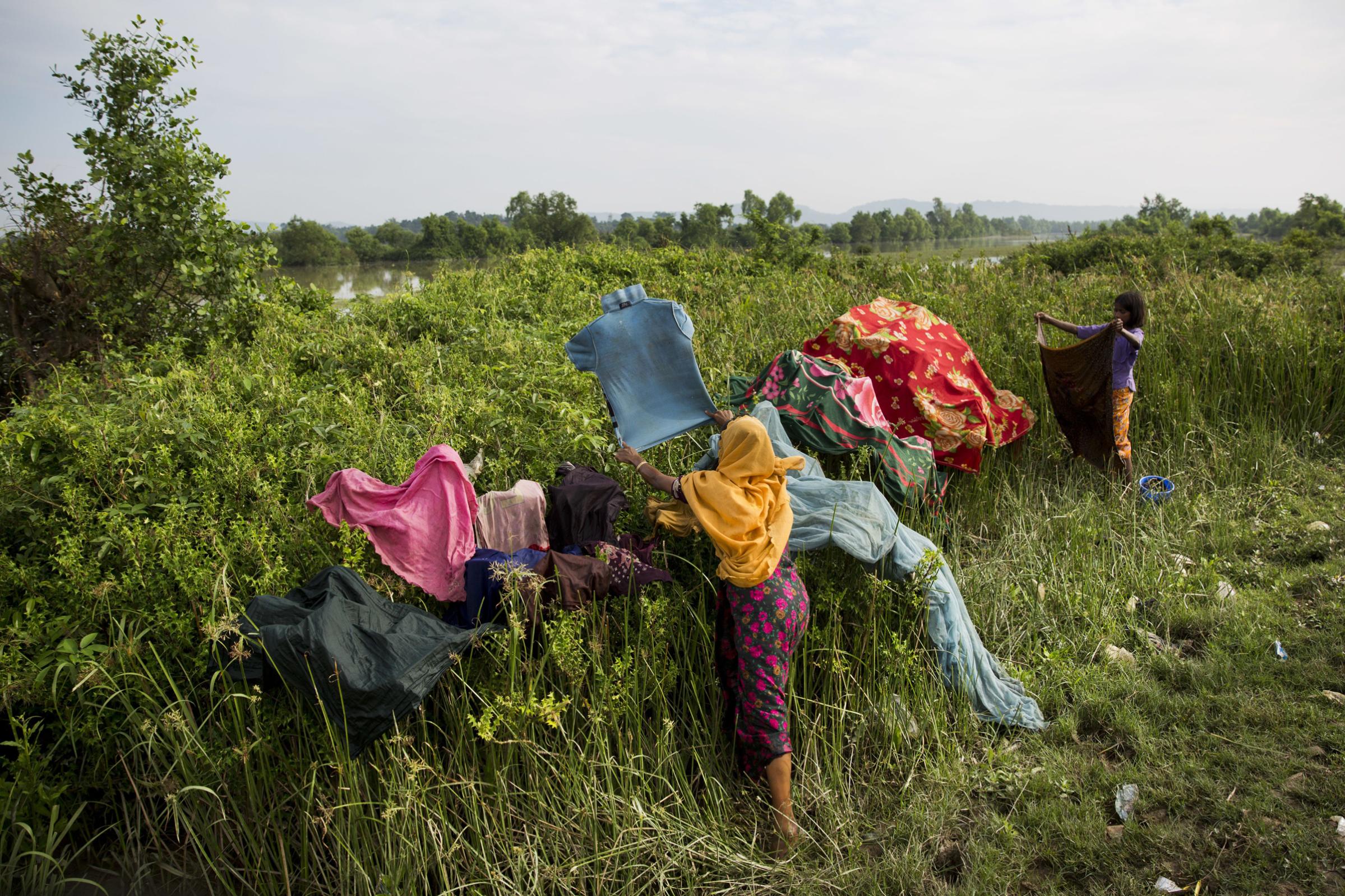Salim is a small boy, but his voice is commanding. His favorite song once floated above the paddy fields of Myanmar’s Rakhine state, heard only by a few grazing cattle and the heavens. Composed in October last year in a melodic dialect similar to Bengali, the words now fall on the rapt ears of children in the world’s largest refugee camp, reminding them why they are there.
What did the miscreants do?
How could they kill our dearest people
What did the culprits do?
Burned everyone, kneeling down
Salim thinks he is 10 years old, but he isn’t sure. He learned to sing from his older brother, before he died at the hands of a Buddhist mob. The family fled, like more than half a million others, across the border into Bangladesh. They now live in a fetid camp, indefinitely, wholly supported by humanitarian aid. Nothing to do, nowhere to go, stripped of all materiality; Salim’s song comes across as an act of instinct, retelling a tale as it was told to him by his closest kin.
When Bangladesh’s borders yielded to the mass of desperate people pouring in from Myanmar in late August, no one predicted the scale of the crisis to come. In the weeks that followed, almost the entire Rohingya population — estimated at 1.1 million inside Myanmar — sought sanctuary as homes and villages went up in flames. Every imaginable horror has been described by those who made it out alive; witnesses said soldiers slaughtered civilians, raped the women, tortured the elderly and burned children to death as they screamed for mercy.
“When I set foot in Bangladesh, I started feeling better,” says Mohammad Ali, a 70-year-old refugee holding an emaciated baby, clinging to the tattered grey T-shirt he has worn since he fled his village of Boli Bazar the Friday before Eid al-Adha. (This Muslim holiday is known in English as “the feast of the sacrifice” and marks the willingness of the prophet Ibrahim, or Abraham, to kill his own son if God so commanded.) A crowd of curious neighbors forms around Mohammad as he speaks in this squalid borough built in the chaotic aftermath of the exodus. This will be the birthplace of a generation of Rohingya, the persecuted Muslim minority known as Asia’s “nowhere people.” Some of the boys will become casualties of the drug trade. Some of the girls will be sold for sex and smuggled abroad. Others will suffer from an almost inevitable outbreak of infectious disease. “At least here, they’re not killing us,” Mohammad says.
The U.N. and the U.S. have described the violence in Myanmar as a campaign of ethnic cleansing, while rights experts say there is evidence of genocide. The former is not an independent crime under international law, but its execution can constitute crimes against humanity. Genocide, on the other hand — defined as the intent to destroy, in whole or in part, a group of people based on their nationality, ethnicity, race or faith — is the world’s most serious crime. But on the Bangladeshi side of the border, this is not a story about justice. It is a story of survival.

The sight of barefoot masses arriving on the shore can only be described as biblical. Well over 622,000 Rohingya have endured the dangerous passage from their homes in Rakhine to the relative safety of Cox’s Bazar, a district of eastern Bangladesh, over the past three months — the fastest refugee movement since the Rwandan genocide. Following a fatal attack on state security forces by Rohingya insurgents on Aug. 25, the Myanmar military unleashed a campaign of terror in the state’s northern townships. Many fled without any belongings at all. Those who could loaded children up in baskets, the elderly on their backs, live chickens and solar panels under their arms. They ran and walked for days, sometimes weeks. Arriving dehydrated, their feet seared and swollen, soldiers shot them from behind as they fled across a border stippled with landmines. More still drowned in the Naf River, a muddy waterway separating Myanmar from the southernmost tip of Bangladesh, as overloaded fishing boats capsized while ferrying them across one final obstacle.
In the early days of the crisis, once safely across they slept on the side of a road with no shelter from rain or sun. A protected forest between two existing camps was felled to make room. In what the U.N. has labeled a “critical humanitarian emergency,” the refugees are now packed into makeshift shelters built from bamboo sticks and tarpaulin sheets. There is little clean water, and there are few service roads. There is no easy way to empty their latrines, which they share with some 400,000 other refugees who arrived before them. Even as more make the crossing, thousands each week until all of northern Rakhine may well be emptied, there is no more land.
Standing atop a hill in the very center of this 10 square mile encampment, flimsy huts canvass the landscape in all directions. It’s a city of sorts, but devoid of all infrastructure, with a population comparable to that of Washington, D.C. Of that population, about 60% are children. A recent survey carried out by the French NGO Action Against Hunger (ACF) found that 7.5% of those children suffer from severe acute malnutrition. About 40,000 of those children are imminently at risk of starvation. The ones who are under six months old, of which there are many, are ten times as likely to die. Those who live long enough to be treated for malnutrition are still vulnerable to other things that can kill them, like diarrhea. Or cholera. Or measles. Or wild elephants.
“This is basically the definition of what we call a ‘complex crisis,’” says Robert Onus, the Emergency Coordinator for Doctors Without Borders in Bangladesh. It’s not primarily a trauma response, as it is in Syria, where he last worked. It’s not a cholera epidemic, where doctors are deployed to treat an illness. It’s not just famine, and it’s not just ethnic or religious or political persecution. It’s all of those things, all at the same time. “If you focus too much on one thing, you’re doing it at the exclusion of a whole range of others — that’s the most complicated part of this,” Onus says.
Almost every day brings some new and alarming revelation: This is the number of children who may starve; this is how many prepubescent girls were raped and require special care; this is the number of days before a cyclonic storm makes landfall. Each on its own distressing, the sum of those parts is an emergency so huge and horrific that few have fully grasped how bad it is, despite an early warning from the U.N. Secretary-General, Antonio Guterres, that Bangladesh was dealing with a “human-rights nightmare.” Setting aside, for now, the residual impacts of trauma, disease and displacement on almost the entirety of an already persecuted — and to a small degree radicalizing — population, humanitarian agencies are struggling simply to keep them alive. “We’re still at the front end of what is about to become the largest refugee response in recent memory,” says Michael Dunford, the Emergency Coordinator for the World Food Program in Cox’s Bazar. “The Bangladeshi government possibly didn’t know what they were signing up for, but thank God they did.”

The Rohingya are unique among the more than 65 million displaced people across the globe. Often referred to as one of the world’s most persecuted minorities, they hold the distinction of being the largest group of stateless people, and perhaps the only one that has been almost completely uprooted. They are a predominantly Sunni Muslim minority that has lived in Myanmar for centuries, and while they have belonged there since 1947, when the partition of the British Indian territories etched a line between what is now Rakhine state and what was then East Pakistan, most of them were later rendered stateless by Myanmar’s former military junta. Decades of nationalist propaganda, often promulgated by rogue Buddhist monks, convinced much of the population that the Rohingya are illegal immigrants from Bangladesh, signaling a Muslim incursion.
Their plight has also significantly shifted the regional narrative of democratic progress. Aung San Suu Kyi, the Nobel Peace Prize laureate who spent decades under house arrest before becoming Myanmar’s de facto civilian leader in 2016, has seen her legacy all but destroyed as she failed to stop or even acknowledge atrocities committed on her watch. In the wake of Suu Kyi’s spectacular undoing, a new hero has presented herself: Sheikh Hasina, the Prime Minister of Bangladesh, whose portrait is now strung on every roadside throughout Cox’s Bazar on vinyl campaign banners lauding “the mother of humanity.”
Itself a poor country and one of the world’s most densely populated, Bangladesh is home to some 163 million people in a space the size of the U.S. state of Georgia. While this overburdened country has shown remarkable generosity, compassion may fade as the country’s scant resources are diverted to people who aren’t its nationals. “Bangladesh is on the verge of unprecedented crisis,” Hasina told lawmakers on Nov. 15, according to the local news website Daily Star, adding that “today’s problem has been created by Myanmar authorities and Myanmar has to solve it.”

Perhaps in anticipation of the public’s eventual fatigue, the Hasina government will not recognize the Rohingya as refugees and says it wants them to return to Myanmar within 18 to 24 months. Suu Kyi has said she hopes to quickly reach a memorandum of understanding with Dhaka “which would enable us to start the safe and voluntary return of all of those who have gone across the border,” according to Reuters. The two governments aspire to an agreement similar to one reached in the 1990s, but humanitarian professionals are not likely to endorse this plan. Human Rights Watch and Amnesty International have both urged caution, while U.N. officials remain unconvinced that such a swift return could be safe, dignified and voluntary. “I think they might be looking with rose-tinted spectacles on this particular issue,” says Sebastian Rhodes Stampa, the U.N. Senior Coordinator for Emergency Response in Cox’s Bazar. “Repatriation after this type of persecution just doesn’t happen in two years.”
The exodus was the fourth of its kind, and in both speed and scale it was the worst. A camp called Kutupalong was established in 1978, and swelled in the early 1990s amid another wave of violence. Other smaller camps were later formed, such as Balukhali, Leda and Nayapara, and some 3-400,000 Rohingya have been scattered across the district for decades. Those who remained in Myanmar lived in ever-deteriorating conditions; restrictions on travel, social services and employment amounted to apartheid, and worsened after deadly riots tore across the state in 2012. Security was then used as a pretext to further isolate them as aid stopped flowing, trade was discontinued and civil servants were no longer deployed to staff Muslim schools and clinics. More than 100,000 have been trapped for years in camps for the internally displaced near the state capital Sittwe, where tens of thousands became so desperate they fled on boats manned by human traffickers, many dying namelessly in the Andaman Sea.
On Oct. 9, 2016, an insurgent group calling itself Harakah al-Yaqin attacked three of the Myanmar military’s border guard posts, killing nine officers and triggering a military lockdown across the state’s north. Within weeks, about 90,000 Rohingya fled to Bangladesh with accounts of rape, torture and extrajudicial killing. The U.N. concluded that the military had likely committed crimes against humanity as it carried out a brutal counter-terrorism operation; more than half of the women interviewed said they had been sexually assaulted, and a majority of those surveyed had seen someone die.
The following month, the U.N. Human Rights Council agreed by consensus to deploy an international fact-finding mission to northern Rakhine, but the Myanmar government will not allow it access. Buckling under international pressure, Suu Kyi has promised to implement a rehabilitation plan created by the Rakhine Commission, an independent advisory board chaired by former U.N. Secretary General Kofi Annan. Just hours after he presented her with his recommendations, on Aug. 25, the insurgents struck again, this time under the name Arakan Rohingya Salvation Army, or ARSA. The Myanmar army responded much as it had in the past, with savagery, and Suu Kyi was once again powerless to stop them.
So many people fled so fast that the entire shared border into Bangladesh was hemorrhaging human beings. About 100,000 are believed to have disappeared into villages where they had an acquaintance — undocumented, uncounted, unreached by aid. Pockets of terrain known as no man’s land, beyond the fence where Myanmar ends but not yet within Bangladesh, became crowded makeshift encampments. The thousands still squatting on these dirty and desolate river banks are kept alive on rice and red lentils delivered by the International Committee of the Red Cross, one of the few organizations allowed access to them. Once there, delivery is made even more complicated by additional stipulations. Forbidden from setting foot in a tributary near the village of Tambru, at exactly noon aid workers instruct refugees to create a human chain of about 40 boys and men standing in the muddy water to pass the goods from one side to the other. “This is food for you and your community!” yells Bal Bhujel, the Regional Economic Security Advisor for ICRC, marshaling the men into action.
Since the August attacks, aid within northern Rakhine has almost completely stopped. ICRC is the only organization allowed to enter the area of operations, where few Rohingya remain. Refugee arrivals slowed in late September, but surged again in mid-October amid what some aid workers assume is a devastating famine that could trigger a final influx. Khaleda Begum, a 50-year-old woman from Alishong village, says the few Muslims left behind are now so terrified of Buddhist vigilantes they will leave their homes for one reason and one reason only: to flee. “If our boys go out on the farm, they get shot,” she says while perched on the side of a paddy field near the Bangladeshi village of Anjumanpara, where she has just sat down after walking for nine days. “We couldn’t do anything, we just waited idly in our houses,” she says. “Then at midnight, they came.”
Despite what they may say, Bangladeshi officials understand that the crisis will not be resolved quickly. Mohammad Abul Kalam, Joint Secretary of Bangladesh’s Refugee Relief and Repatriation Commission, acknowledges that “we may have to prepare, maybe, for the long-term,” and says it is “the moral obligation of the international community to stand by Bangladesh,” however long it takes. Proving that commitment, Dhaka has already allocated 3,000 acres of land for refugee housing, and is weighing the U.N.’s recommendation to scrap a “mega camp” blueprint in favor of three or four smaller sites that would be more easily serviced and could isolate sickness in the event of an outbreak.

Goodwill exists in abundance, but resources are finite. The U.N. is by far the largest actor in the crisis with a $434 million emergency response plan covering all agency operations through February. But the body’s idiosyncratic funding scheme operates in six-month intervals, hindering long-term solutions. Moreover, competing catastrophes divert what aid exists, and donors must decide which lives matter most. A pledging conference held in October locked in 82% of the U.N.’s budget for the crisis, but any shortfall will surely lead to suffering. Even amid what is viewed as a crisis overwhelmingly affecting children, UNICEF has only secured 34% of its $76 million funding goal for the current period.
Upon their arrival in Bangladesh, a little more than a quarter of the refugees were vaccinated for measles and rubella in a massive drive targeting children from six months to 15 years of age, and a second round of catch-up vaccinations is well underway to reach its target of 336,943 children. Beginning in mid-October, more than 700,000 cholera vaccines were administered to vulnerable refugees, the largest and fastest drive ever attempted. But in a humanitarian response, even the most solid success belies failure. While there is now enough food and shelter to keep these roughly one million inhabitants alive, and while there are more than enough latrines to accommodate them, those facilities are not maintained. “If you were to make a checklist of all the ingredients for an outbreak, here you would check almost every box,” says Onus, of Doctors Without Borders.
Water, sanitation and hygiene services, known in the aid world as WASH, have only been delivered to about half of those in need. Roughly 95% of refugees are already consuming contaminated water, according to the International Rescue Committee, with two thirds of supply found to contain feces. A latrine may be usable for about two months, once full an “X” will be scrawled on its side and a new one installed just a few feet away. Agencies such as UNICEF are working toward waste management solutions, but emptying some latrines would require physically shoveling waste into a bucket and carrying it by foot to the nearest motor road, which in some cases is six kilometers away; over hills, across rickety bamboo footbridges and through lanes overcrowded with unaccompanied toddlers who, oftentimes, aren’t wearing any clothes.
The world looks different after a tragedy. Surveying the scene from a hilltop on a recent afternoon, light rain begins to fall. Just a short shower is enough to turn footpaths into perilous slopes, and streams into toxic pools. Even ordinary things, like drops of water, can cause terror. We left before dark, as is the rule, followed by a chorus of bloated and half-naked children who have picked up a few words of English here and there. Their singsong refrain is familiar to most who have ever been a stranger on a visit to a refugee camp. “Bye bye,” the children sing to our backs as we leave. “Thank you.”
— With video by Helen Regan / Cox’s Bazar, Bangladesh
More Must-Reads from TIME
- Caitlin Clark Is TIME's 2024 Athlete of the Year
- Where Trump 2.0 Will Differ From 1.0
- Is Intermittent Fasting Good or Bad for You?
- The 100 Must-Read Books of 2024
- Column: If Optimism Feels Ridiculous Now, Try Hope
- The Future of Climate Action Is Trade Policy
- FX’s Say Nothing Is the Must-Watch Political Thriller of 2024
- Merle Bombardieri Is Helping People Make the Baby Decision
Contact us at letters@time.com